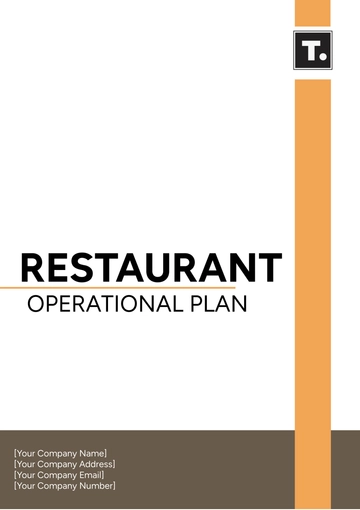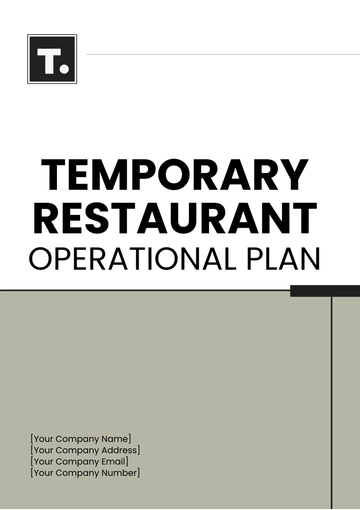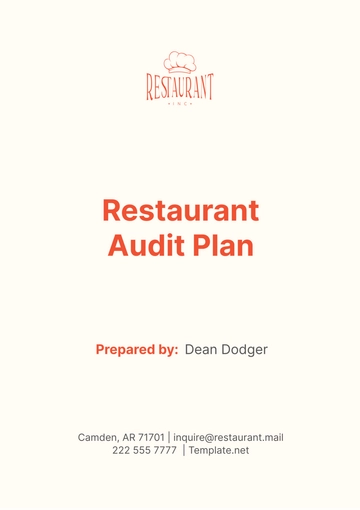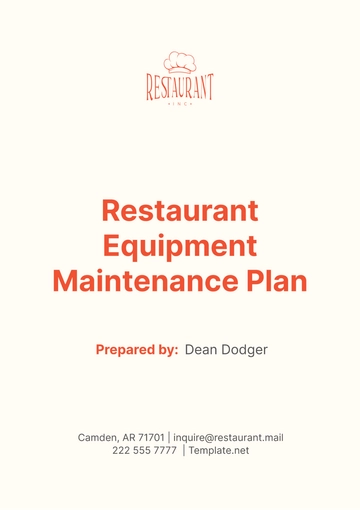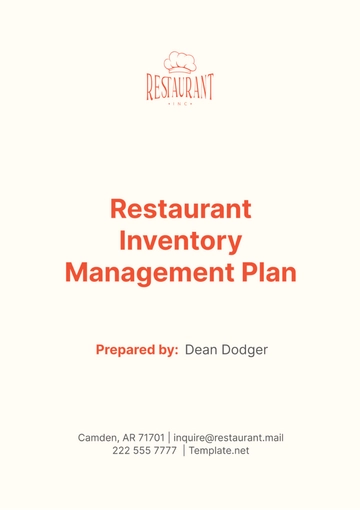Free Restaurant Inventory Management Plan
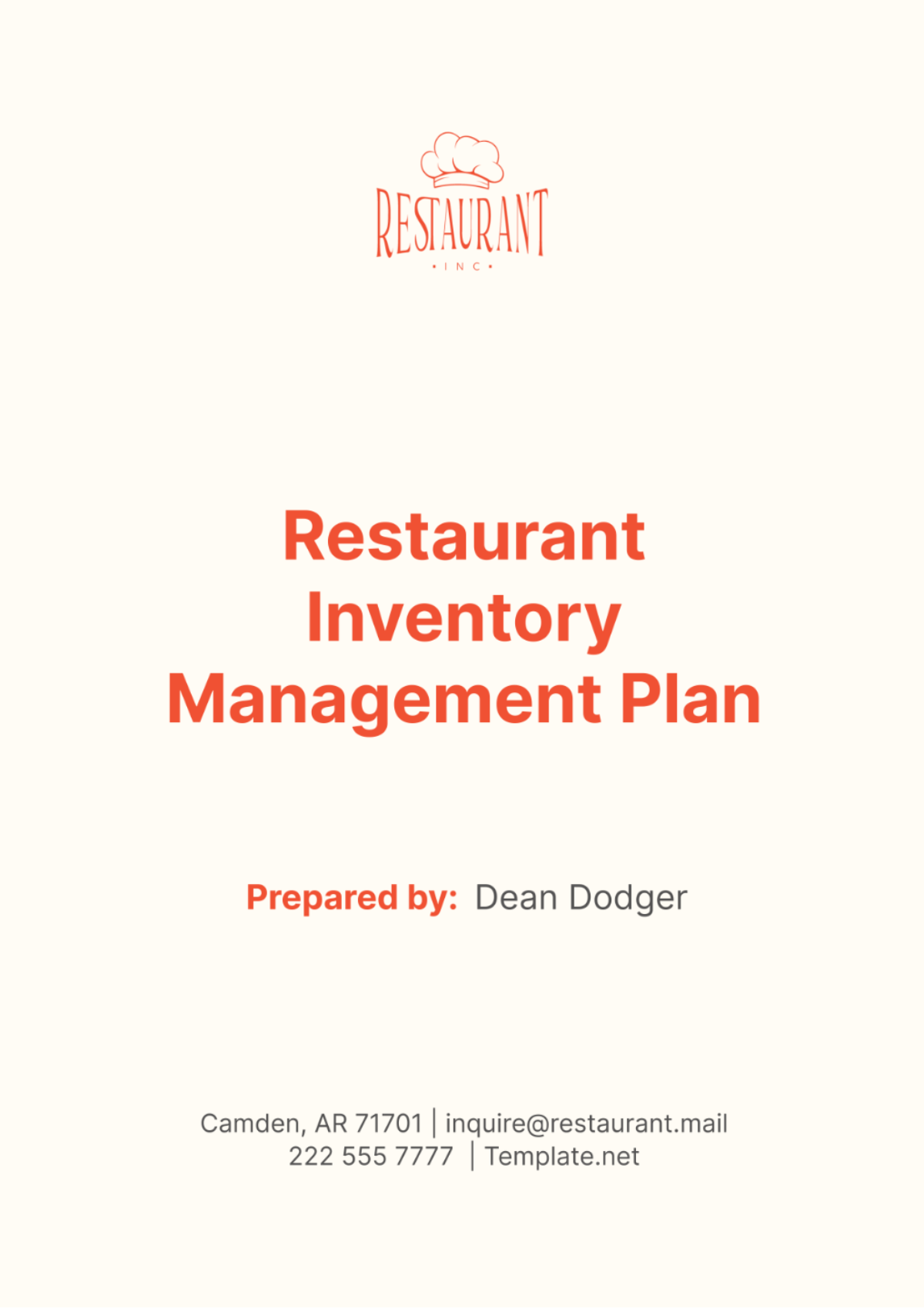
I. Introduction
A. Overview of the Importance of Inventory Management
Effective inventory management is the backbone of our restaurant's operations, impacting everything from food quality to financial stability. By keeping precise control over our inventory, we can minimize waste, optimize purchasing, and ensure that we always have the right ingredients on hand to meet customer demand.
B. Objectives of the Inventory Management Plan
Our Inventory Management Plan aims to achieve several key objectives:
Ensure accurate tracking and monitoring of inventory levels.
Minimize costs associated with overstocking and waste.
Streamline inventory replenishment processes for maximum efficiency.
Improve forecasting accuracy to better anticipate customer demand.
Enhance overall operational performance and profitability through effective inventory management practices.
II. Inventory Tracking System
A. Description of the Inventory Tracking System Used
Our restaurant utilizes a state-of-the-art cloud-based inventory management software that provides real-time visibility into inventory levels, transactions, and usage patterns. This system allows us to track inventory across multiple locations, set up automated reorder points, and generate detailed reports for analysis.
B. Procedures for Recording Inventory Transactions
All inventory transactions, including receiving, usage, and adjustments, are recorded electronically in our inventory management system. Staff members are trained to accurately record transactions in real-time to maintain accurate inventory records and facilitate timely decision-making.
C. Training Requirements for Staff on Using the Inventory Tracking System
All staff members involved in inventory management undergo comprehensive training on how to use the inventory management software effectively. Training includes instruction on recording transactions, conducting inventory counts, analyzing reports, and troubleshooting common issues to ensure proficiency and accuracy.
III. Inventory Procedures
A. Inventory Receiving Procedures
Upon delivery, incoming inventory undergoes thorough inspection and verification by receiving staff to ensure quality and accuracy. Any discrepancies are documented, and appropriate action is taken to resolve issues promptly. Accepted items are properly labeled, tagged, and stored in designated storage areas.
B. Storage and Organization Guidelines
Inventory items are stored in designated storage areas according to type, category, and shelf life to prevent cross-contamination and spoilage. Perishable items are stored in temperature-controlled environments, while dry goods are stored in dry, well-ventilated areas. Proper labeling, shelving, and FIFO (First In, First Out) rotation are enforced to maintain inventory integrity and minimize waste.
C. Inventory Counting and Auditing Procedures
Regular inventory counts are conducted to verify the accuracy of inventory records and identify any discrepancies or irregularities. Full inventory counts are performed monthly, while spot checks are conducted weekly to ensure ongoing accuracy. Any discrepancies are investigated, documented, and reconciled promptly to maintain inventory integrity.
IV. Forecasting and Ordering
A. Methods Used for Forecasting Demand
We utilize a combination of historical sales data, seasonal trends, market analysis, and customer feedback to forecast future demand for inventory items. These methods enable us to anticipate fluctuations in demand and adjust our inventory levels accordingly to avoid stockouts or overstocking.
B. Determining Optimal Inventory Levels
Optimal inventory levels are determined based on factors such as sales forecasts, lead times, desired service levels, and storage capacity. Safety stock levels are established to mitigate the risk of stockouts and ensure continuity of operations during unexpected fluctuations in demand or supply.
C. Procedures for Placing Orders with Suppliers
Orders are placed with approved suppliers through our inventory management system or directly via email or phone. Purchase orders specify quantities, delivery dates, and any special instructions, ensuring clear communication and accurate fulfillment of orders.
D. Vendor Management and Communication Protocols
We maintain open lines of communication with our suppliers to facilitate timely delivery of inventory items and address any issues or concerns that may arise. Regular vendor meetings and performance reviews help to strengthen relationships and ensure mutual understanding of expectations and requirements.
V. Supplier Management
A. List of Approved Suppliers
We maintain a list of approved suppliers who have been vetted for product quality, reliability, pricing, and service level agreements. Suppliers undergo a rigorous evaluation process before being added to the approved vendor list to ensure they meet our standards and requirements.
B. Criteria Used for Selecting Suppliers
When selecting suppliers, we consider factors such as product quality, pricing, reliability, delivery times, and customer service. We prioritize suppliers who offer competitive pricing without compromising on quality and who demonstrate a commitment to customer satisfaction.
C. Negotiation Strategies for Obtaining Competitive Pricing
We employ negotiation strategies such as volume discounts, price matching, and favorable payment terms to obtain competitive pricing from our suppliers. These strategies help us to maximize cost savings while maintaining the quality and integrity of our inventory.
D. Evaluation and Performance Monitoring of Suppliers
Supplier performance is regularly monitored and evaluated based on key performance indicators such as on-time delivery, order accuracy, product quality, and responsiveness to issues. Suppliers who consistently meet or exceed performance metrics are recognized and rewarded, while those who fall short are provided with feedback and support to improve.
VI. Inventory Control Measures
A. Inventory Turnover Analysis
We regularly analyze inventory turnover ratios to assess the efficiency of our inventory management practices and identify areas for improvement. By optimizing inventory turnover, we can reduce holding costs, minimize waste, and improve cash flow.
B. Cost Control Strategies
We implement cost control strategies such as bulk purchasing, price negotiation, and inventory optimization to minimize costs associated with inventory management. These strategies help us to maximize profitability while maintaining quality and service levels.
C. Minimizing Shrinkage and Losses
We implement strict inventory control measures such as employee training, security protocols, and surveillance to minimize shrinkage and losses due to theft, spoilage, or mismanagement. By proactively addressing potential risks, we can safeguard our inventory and protect our bottom line.
D. Implementing FIFO (First In, First Out) Methodology
We adhere to the FIFO (First In, First Out) methodology to ensure that older inventory items are used or sold before newer ones. This practice helps to minimize waste and spoilage by ensuring that inventory items are rotated and consumed in a timely manner.
VII. Waste Reduction Strategies
A. Portion Control Guidelines
We implement portion control guidelines to minimize food waste and ensure consistency in serving sizes. Staff members are trained to follow standardized portion sizes and techniques to reduce over-portioning and excess food preparation.
B. Proper Handling of Perishable Items
Perishable items are closely monitored to prevent spoilage and waste. Staff members receive training on proper storage techniques, temperature control, and rotation procedures to ensure that perishable inventory items are used before reaching their expiration dates.
C. Staff Training on Waste Reduction Techniques
All staff members undergo training on waste reduction techniques and best practices. Training includes education on identifying and addressing sources of waste, implementing portion control measures, and maximizing the use of ingredients to minimize food waste.
VIII. Technology Integration
A. Inventory Management Software Used
We utilize a comprehensive inventory management software that integrates with our point-of-sale system to provide real-time visibility into inventory levels, sales data, and purchasing trends. This software streamlines inventory processes, automates reorder notifications, and generates reports for analysis.
B. Integration with Point-of-Sale (POS) System
Our inventory management software seamlessly integrates with our point-of-sale system, allowing for automatic updates of inventory levels with each transaction. This integration improves accuracy, reduces manual data entry errors, and facilitates efficient inventory management.
C. Utilization of Barcoding or RFID Technology
We utilize barcoding or RFID (Radio Frequency Identification) technology to track inventory items throughout the supply chain. Barcodes or RFID tags are affixed to each item, enabling quick and accurate scanning for inventory counts, receiving, and sales transactions.
IX. Staff Training and Responsibilities
A. Training Program for Staff Involved in Inventory Management
We provide comprehensive training programs for staff members involved in inventory management, including receiving, storage, and ordering procedures. Training is conducted regularly to ensure that staff members are proficient in their roles and responsibilities.
B. Clearly Defined Roles and Responsibilities
Each staff member involved in inventory management has clearly defined roles and responsibilities outlined in their job descriptions. This includes tasks such as receiving shipments, conducting inventory counts, placing orders, and maintaining accurate records.
C. Cross-Training to Ensure Redundancy and Flexibility
We cross-train staff members to ensure redundancy and flexibility in our inventory management processes. This allows for seamless transition between tasks and ensures that operations continue smoothly in the event of staff absences or turnover.
X. Continuous Improvement
A. Regular Review and Evaluation of Inventory Management Processes
We conduct regular reviews and evaluations of our inventory management processes to identify areas for improvement. This includes analyzing performance metrics, soliciting feedback from staff members, and implementing changes to optimize efficiency and effectiveness.
B. Feedback Mechanisms for Staff Input
We encourage staff members to provide feedback and suggestions for improving inventory management practices. This may include suggestions for process improvements, software enhancements, or supplier relationships.
C. Implementation of Changes and Updates to the Plan
Based on feedback and performance evaluations, we implement changes and updates to our Inventory Management Plan as needed. This may include revising procedures, providing additional training, or adopting new technologies to enhance efficiency and effectiveness.
XI. Conclusion
A. Summary of Key Points Covered in the Plan
Our Inventory Management Plan outlines procedures and protocols for effectively managing inventory levels, reducing waste, and optimizing operational efficiency. By implementing these strategies, we aim to improve profitability and customer satisfaction while minimizing costs and waste.
B. Commitment to Effective Inventory Management Practices
We remain steadfastly committed to upholding and continually enhancing our already rigorous inventory management practices. It is our objective to consistently refine these processes in order to adapt to and effectively serve the changing demands of both our restaurant operations and our valued customers.
C. Acknowledgment of Staff Contributions and Support
We extend our appreciation to all staff members who contribute to the success of our inventory management efforts. Their dedication, diligence, and teamwork are essential to achieving our goals and delivering exceptional service to our customers.
- 100% Customizable, free editor
- Access 1 Million+ Templates, photo’s & graphics
- Download or share as a template
- Click and replace photos, graphics, text, backgrounds
- Resize, crop, AI write & more
- Access advanced editor
Compose efficient inventory management strategies effortlessly with the Restaurant Inventory Management Plan Template from Template.net. This editable and customizable template equips you with the tools needed to streamline inventory processes. Utilize the AI Editor Tool to tailor the plan to your restaurant's unique needs, ensuring optimal stock levels and minimized waste.
You may also like
- Finance Plan
- Construction Plan
- Sales Plan
- Development Plan
- Career Plan
- Budget Plan
- HR Plan
- Education Plan
- Transition Plan
- Work Plan
- Training Plan
- Communication Plan
- Operation Plan
- Health And Safety Plan
- Strategy Plan
- Professional Development Plan
- Advertising Plan
- Risk Management Plan
- Restaurant Plan
- School Plan
- Nursing Home Patient Care Plan
- Nursing Care Plan
- Plan Event
- Startup Plan
- Social Media Plan
- Staffing Plan
- Annual Plan
- Content Plan
- Payment Plan
- Implementation Plan
- Hotel Plan
- Workout Plan
- Accounting Plan
- Campaign Plan
- Essay Plan
- 30 60 90 Day Plan
- Research Plan
- Recruitment Plan
- 90 Day Plan
- Quarterly Plan
- Emergency Plan
- 5 Year Plan
- Gym Plan
- Personal Plan
- IT and Software Plan
- Treatment Plan
- Real Estate Plan
- Law Firm Plan
- Healthcare Plan
- Improvement Plan
- Media Plan
- 5 Year Business Plan
- Learning Plan
- Marketing Campaign Plan
- Travel Agency Plan
- Cleaning Services Plan
- Interior Design Plan
- Performance Plan
- PR Plan
- Birth Plan
- Life Plan
- SEO Plan
- Disaster Recovery Plan
- Continuity Plan
- Launch Plan
- Legal Plan
- Behavior Plan
- Performance Improvement Plan
- Salon Plan
- Security Plan
- Security Management Plan
- Employee Development Plan
- Quality Plan
- Service Improvement Plan
- Growth Plan
- Incident Response Plan
- Basketball Plan
- Emergency Action Plan
- Product Launch Plan
- Spa Plan
- Employee Training Plan
- Data Analysis Plan
- Employee Action Plan
- Territory Plan
- Audit Plan
- Classroom Plan
- Activity Plan
- Parenting Plan
- Care Plan
- Project Execution Plan
- Exercise Plan
- Internship Plan
- Software Development Plan
- Continuous Improvement Plan
- Leave Plan
- 90 Day Sales Plan
- Advertising Agency Plan
- Employee Transition Plan
- Smart Action Plan
- Workplace Safety Plan
- Behavior Change Plan
- Contingency Plan
- Continuity of Operations Plan
- Health Plan
- Quality Control Plan
- Self Plan
- Sports Development Plan
- Change Management Plan
- Ecommerce Plan
- Personal Financial Plan
- Process Improvement Plan
- 30-60-90 Day Sales Plan
- Crisis Management Plan
- Engagement Plan
- Execution Plan
- Pandemic Plan
- Quality Assurance Plan
- Service Continuity Plan
- Agile Project Plan
- Fundraising Plan
- Job Transition Plan
- Asset Maintenance Plan
- Maintenance Plan
- Software Test Plan
- Staff Training and Development Plan
- 3 Year Plan
- Brand Activation Plan
- Release Plan
- Resource Plan
- Risk Mitigation Plan
- Teacher Plan
- 30 60 90 Day Plan for New Manager
- Food Safety Plan
- Food Truck Plan
- Hiring Plan
- Quality Management Plan
- Wellness Plan
- Behavior Intervention Plan
- Bonus Plan
- Investment Plan
- Maternity Leave Plan
- Pandemic Response Plan
- Succession Planning
- Coaching Plan
- Configuration Management Plan
- Remote Work Plan
- Self Care Plan
- Teaching Plan
- 100-Day Plan
- HACCP Plan
- Student Plan
- Sustainability Plan
- 30 60 90 Day Plan for Interview
- Access Plan
- Site Specific Safety Plan


